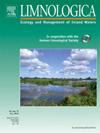Chironomidae communities from the Mazafran watershed as bioindicators of water quality and biodiversity with implications for global freshwater ecosystems
IF 2
4区 环境科学与生态学
Q2 LIMNOLOGY
引用次数: 0
Abstract
This study investigates the use of Chironomidae communities as bioindicators to evaluate biodiversity and water quality in freshwater habitats. A crucial sub-basin in a north African coastal area, it is subject to severe pollution and urbanisation pressures, which makes it a perfect model for comprehending how human activity affects aquatic ecosystems. We performed physico-chemical assessments of water quality indicators, in addition to monthly sampling of Chironomidae larvae and macroinvertebrates at 13 sites during a one-year period. Chironominae and Orthocladiinae emerged as the leading subfamilies among the 55 Chironomidae taxa, which comprise 30,145 individuals. As a result, downstream stations showed indications of severe contamination, but upstream stations had the maximum species diversity. The Canonical Correspondence Analysis (CCA) demonstrated the sensitivity of Chironomidae to habitat conditions by revealing robust connections between environmental variables and species distribution. While Orthocladius rubicundus was a critical signal of high-water quality upstream, the Dominant Species Chironomid Index (D.S.C.I.) further confirmed considerable water quality degradation downstream, in contrast to the biological balance observed upstream. These results highlight the usefulness of biotic indices based on Chironomidae for biomonitoring and offer important management insights for freshwater ecosystems in areas affected by pollution and urbanisation.
马扎夫兰流域的手蛾科群落作为水质和生物多样性的生物指标及其对全球淡水生态系统的影响
本研究利用摇蝇科群落作为生物指标评价淡水生境的生物多样性和水质。它是北非沿海地区一个重要的子盆地,受到严重的污染和城市化压力,这使它成为理解人类活动如何影响水生生态系统的完美模型。在一年的时间里,我们对水质指标进行了物理化学评估,并在13个地点每月取样手摇蚊幼虫和大型无脊椎动物。Chironominae和Orthocladiinae是55个Chironominae分类群中最主要的亚科,共有30145个个体。结果表明,下游站点污染严重,但上游站点的物种多样性最大。典型对应分析(CCA)通过揭示环境变量与物种分布之间的强大联系,揭示了手摇蝇科对生境条件的敏感性。虽然rubicundus是上游高水质的关键信号,但优势种Chironomid指数(D.S.C.I.)进一步证实了下游水质的严重退化,与上游的生物平衡相反。这些结果强调了基于手蛾科生物指数的生物监测的有效性,并为受污染和城市化影响地区的淡水生态系统管理提供了重要的见解。
本文章由计算机程序翻译,如有差异,请以英文原文为准。
求助全文
约1分钟内获得全文
求助全文
来源期刊

Limnologica
环境科学-湖沼学
CiteScore
3.70
自引率
5.90%
发文量
64
审稿时长
3 months
期刊介绍:
Limnologica is a primary journal for limnologists, aquatic ecologists, freshwater biologists, restoration ecologists and ecotoxicologists working with freshwater habitats.
 求助内容:
求助内容: 应助结果提醒方式:
应助结果提醒方式:


